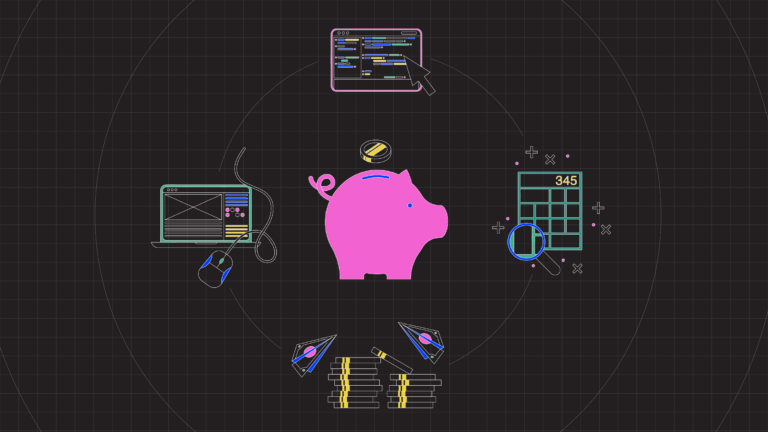The high cost of cheap dev: Why working with a full-service consultancy is a better investment

We get it. No one wants to pay more than necessary for anything, including development work. So, when looking at bids for your next user experience project, it’s tempting to go with the lowest-priced option. After all, code is code, right?
Not exactly. What may seem like an obvious money-saving decision can eventually become a much more expensive proposition. Great user experience (UX) isn’t just about how something looks—it’s also about how it works. Low-cost development companies often miss this critical connection, leading to clunky, inefficient products. In fact, we’ve worked with many clients to fix issues that low-cost development companies have left behind. Choosing a full-service consultancy with a higher upfront price over a low-cost development firm will save you money and headaches in the long run.
The hidden risks of low-cost development
To make any money at all, low-cost development companies have to cut corners somewhere, and these cuts create issues and raise costs for their clients. Some of the most common problems include:
The experience gap
Payroll is always the highest expense for any development consultancy, and low-cost development can’t afford to hire top talent. They typically employ developers with very little front-end coding experience or that give little attention to the intended user experience. We’ve seen cases where development teams used WYSIWYG (what you see is what you get) tools several layers removed from actual code, resulting in inflexible, hard-to-maintain solutions. These firms also often struggle with high turnover because as soon as developers gain enough experience to land better-paying jobs, they’re out the door.
The separation of design and development
Integration between design and development requires expertise, collaboration, and time—three things that low-cost development firms are unable to prioritize while also keeping prices low. Instead, these firms often operate in silos, treating development as a mechanical process, rather than a strategic one. When developers create code without the user experience in mind, it results in a product that feels disconnected, requires costly rework, and ultimately fails to deliver the seamless experience that users expect.
Technical debt: The gift that keeps on taking
Poor coding practices are like termites in your codebase. They might not be visible at first, but all the while, they’re steadily eating away at your foundation. Take cascading style sheets (CSS), for example. Developers use CSS to structure the styling of entire sites, so that things that are supposed to be consistent can be, and exceptions are handled in a logical, maintainable way.
As sites grow, it may become tempting for inexperienced or rushed developers to implement styling overrides outside of the cascading nature of CSS. CSS allows for things like the !important flag, which can be a quick-fix, but using them as a matter of course eventually makes the CSS almost useless. We’ve encountered sites with dozens of !important flags per page, creating a nightmare scenario for maintenance, forcing future developers to untangle overrides with more overrides or set aside time for complete refactoring, adding hundreds of hours to future development work.
Quality assurance nightmares
Inexperienced developers using clunky, drag-and-drop development tools often produce buggy code that requires an extensive QA process. In one recent project, the external developer’s code was so problematic that only 27% of test cases passed the first round of testing, requiring an additional 212 hours of QA work. These extra hours aren’t just expensive, they can delay launches, extend project timelines, and eat into time that could have been spent implementing new features.
Compliance complications
For organizations in regulated industries, the stakes are even higher. Regulatory requirements often include specific design elements that must be implemented precisely. We’ve seen cases where implementing a specific, required font took a low-cost development firm three months to get right, likely because they were using tools that couldn’t properly incorporate custom typefaces. An experienced front-end developer could make these changes in a matter of minutes. And, with legal reviews typically happening monthly in highly regulated industries, each failed implementation can delay a project by weeks or even months.
The full-service advantage
Bids can be deceiving because a higher bid doesn’t necessarily mean that a full-service consultancy will be more expensive in terms of value and total cost of ownership (TCO). A full-service consultancy brings together experienced developers, designers, project managers, content strategists, and more, fostering a collaborative-first environment where every aspect of the project is considered. This leads to more efficient workflows, higher-quality deliverables, and ultimately, a stronger ROI for businesses.
Seamless integration of design and development
One of the biggest benefits of working with a full-service consultancy is the direct communication and continuous collaboration between design and development teams.
A full-service approach ensures that technical feasibility is considered from the very start, not as an afterthought. When developers provide technical input early in the design process, potential problems can be caught and addressed before they become expensive and time-consuming roadblocks.
A well-integrated team ensures that designers understand technical constraints while developers grasp the importance of usability. This collaboration prevents misalignment and reduces the need for rework, saving time and money that would otherwise be spent on workarounds. It also reduces the risk of miscommunication, which can occur when separate teams hand off work with little context.
Full-service consultancies can help streamline workflows and deliver a more cohesive user experience—one that functions intuitively and meets user expectations.
Quality-first development
Experienced developers implement a proper component architecture and follow sustainable coding practices. They provide clear, thorough documentation that makes maintenance less expensive and creates a solid foundation that allows your team to be agile in product improvements—adding new capabilities and features quickly. This approach might seem more expensive initially, but it pays big dividends in the long run. Two years down the line, when your organization wants to add a new digital product to the website or update the internal software system, well-documented and architected code will make it far easier and more cost-efficient to deliver.
Getting it right the first time with a dedicated team
Full-service consultancies provide their clients with a dedicated team of experienced developers and designers who collaborate hand-in-hand and know how to create complex, high-quality products that deliver the intended experience the first time around.
Here is a real-world example that starkly illustrates the difference: An external developer who our client had hired (we did the design) once claimed a data visualization was impossible to implement. After the client pushed back, they backtracked and said it would take a few months. Our team delivered the same visualization in 24 hours. Full-service teams ensure that clients get the features they want on time, providing more value for their investment.
The power of a dedicated development team
The tech industry is known for high turnover, but low-cost development shops take it to an extreme. High-quality, full-service consultancies place a high priority in talent retention, and they invest considerable time, money, and resources into ensuring they provide a great place for developers and designers to work. Continuous learning opportunities like trainings, workshops, conferences, and mentorship programs contribute significantly to a developer’s decision to stay with a company long-term. Teams with high retention are able to maintain consistent knowledge of their projects.
Don’t be fooled by low-cost development.
Discover how our experts can help deliver high quality code and long-term cost savings.
Do you have the right development partner?
Be on the lookout for these red flags if you’re starting to feel like your development partner may be wasting your time—and money.
- Adversarial behavior when faced with challenges: Firms that don’t have the coding skills to meet client demands often become combative.
- Inability to implement basic features: The easy stuff should be easy. If the firm can’t deliver basic functionality, that is a bad sign. The CSS (cascading style sheets) examples above are good examples of a development team that is lacking the capability to deliver—simple changes like color, font, and link style shouldn’t take weeks.
- Excessive use of technical excuses to avoid work: Technical issues are a fact of life when implementing digital products, especially innovative ones. But, when strong firms encounter technical issues, they search for ways to overcome them instead of using them as an excuse to avoid delivering promised functionality.
- Limited understanding of UX: Without a strong UX perspective, developers may make decisions that compromise usability, requiring costly redesigns and fixes later.
On the flip side, look for these value indicators:
- A solutions-oriented approach to problems: There will always be some give and take in a client-developer relationship. However, high-quality firms focus on finding solutions, not putting up roadblocks.
- A strong track record in your industry: The right firms can produce strong, relevant references. If the firm you’re using can’t do so, that’s a sign they may not be up to the challenge.
- Design and development integration: When design and development are aligned from the very beginning, the user experience is considered at every stage, ensuring that functionality supports design intent and vice versa.
- Development team stability: Complex projects require a solid, stable team to retain knowledge and develop a sense of the overall project. Constant turnover means the team is repeatedly starting over from scratch mid-stream.
User-focused development builds long-term value
Here’s the bottom line. On paper, the hourly rates of a full-service consultancy might appear higher, but the total cost of ownership (TCO) is typically lower. Quality code, efficient processes, and integrated, experienced teams mean fewer surprises and faster delivery. But perhaps most importantly, building a long-term relationship with a consultancy gives you a partner that can grow with you as your business expands. You gain a team with deep institutional knowledge of user experience, your systems, technical expertise, and design capabilities—all crucial elements for achieving ambitious business goals.
Ready to evaluate your options? Look beyond hourly rates to consider the total cost and long-term impact of your development partner of choice. Your future business success may depend on it. Let’s connect to discuss how a full-service approach can benefit your next project.



